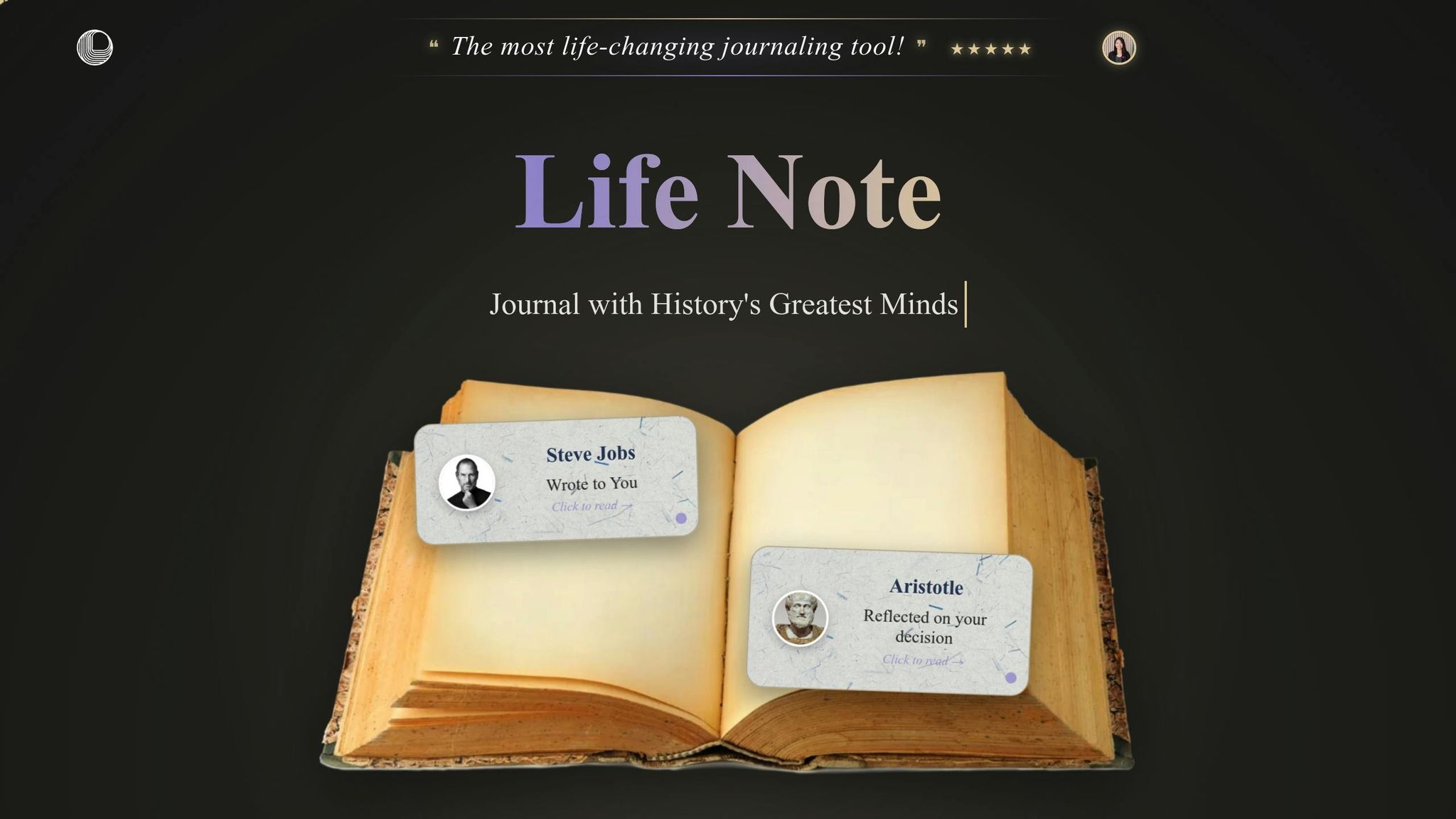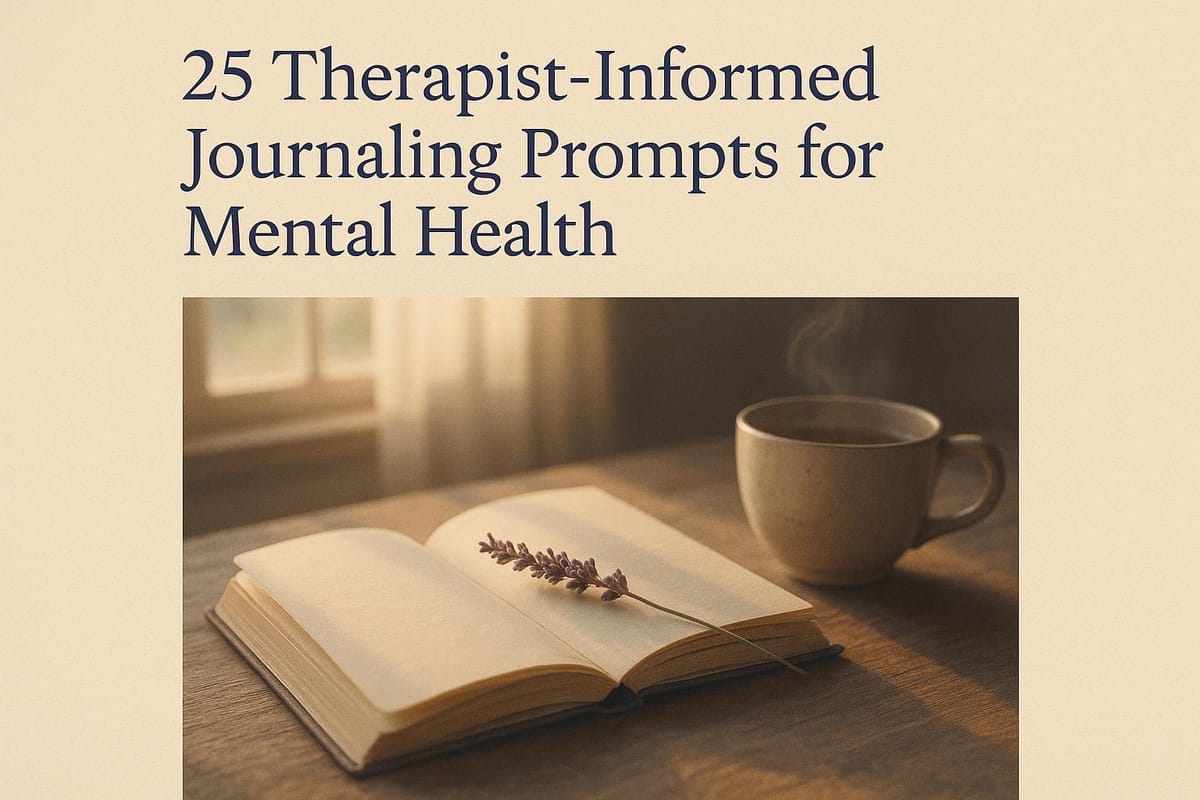7 Therapeutic Journal Prompts for Deep Healing
Explore therapeutic journal prompts to spark reflection, emotional relief, and growth. Start your healing journey with 7 practical prompts today.

Feeling stuck in a loop of anxiety, grief, or self-doubt? The blank page can feel intimidating, but the right key can unlock profound healing. This guide isn't just another list of questions; it's a comprehensive roadmap to distinct, evidence-based therapeutic journaling methods designed to help you navigate your inner world with confidence and clarity.
We'll move beyond generic advice to explore the science and soul behind each technique. You'll learn how to apply structured methods like Cognitive Behavioral Therapy (CBT) journaling to reframe negative thoughts and how to use expressive writing for emotional release. This article provides a complete toolkit of therapeutic journal prompts and frameworks, tailored for challenges ranging from decision-making to healing past wounds.
Our goal is to transform your journal from a simple diary into a powerful tool for self-discovery and emotional regulation. In this comprehensive roundup, you will find:
- Seven distinct journaling techniques: From gratitude and mindfulness to narrative therapy and somatic awareness.
- Specific, actionable prompts: Carefully crafted questions to guide your reflection for each method.
- Practical implementation tips: Guidance on how to start, when to use each style, and how to pace your practice.
- Real-world examples: Sample responses to illustrate how these prompts work in practice.
By the end of this article, you will have the knowledge to choose the right therapeutic journaling approach for your unique needs. You'll be equipped not just with what to write, but a deeper understanding of why it works, empowering you to begin a more intentional and healing journaling practice today.
1. Gratitude and Appreciation Journaling
Gratitude journaling is a foundational practice in therapeutic writing, celebrated for its profound and evidence-based impact on mental well-being. Popularized by researchers like Dr. Martin Seligman at the University of Pennsylvania, this technique involves regularly documenting things you are thankful for, shifting your cognitive focus from deficits to abundance. This isn't about ignoring life's challenges; it's about training your brain to notice the good that coexists with the difficult.
This practice acts as a mental counterbalance to our brain's natural negativity bias, the evolutionary tendency to focus on threats and problems. By consciously seeking out and recording positive experiences, you actively build new neural pathways, fostering resilience, reducing depressive symptoms, and increasing overall happiness.
How to Implement Gratitude Journaling
For this therapeutic journal prompt to be effective, consistency and specificity are key. Move beyond generic lists and dive into the sensory details and emotional impact of your gratitude.
- The "Three Good Things" Practice: Before bed, write down three things that went well during the day. For each one, briefly describe why it happened. For example, instead of "I'm grateful for my friend," write, "I'm grateful my friend called to check on me; it made me feel seen and cared for during a stressful week."
- Morning Gratitude Lists: Start your day by listing 3-5 things you are grateful for before engaging with emails or social media. This can range from the comfort of your bed to the anticipation of a good cup of coffee, setting a positive tone for the hours ahead.
- Evening Appreciation: Reflect on an unexpected kindness you witnessed or received. It could be a stranger holding a door or a colleague offering help. Documenting these small moments reinforces a sense of social connection and safety.
Tips for Deeper Reflection
To prevent your gratitude practice from becoming a robotic chore, go deeper. Explore the "why" behind your gratitude. Ask yourself what this person, object, or experience truly brings to your life. Reviewing past entries during difficult times can also serve as a powerful reminder of the enduring presence of good in your world, providing perspective when you need it most.
For a structured approach to building a lasting practice, you can explore this practical guide to gratitude journaling that actually sticks.
2. Cognitive Behavioral Therapy (CBT) Journaling
Cognitive Behavioral Therapy (CBT) journaling is a structured, therapeutic approach that translates clinical principles into a powerful self-help tool. Pioneered by Dr. Aaron T. Beck, this technique empowers you to become an observer of your own mind. It involves systematically identifying, challenging, and reframing the automatic negative thoughts (ANTs) that often fuel distress, anxiety, and depression.
This method operates on the core CBT principle that our thoughts, feelings, and behaviors are interconnected. By documenting a challenging situation and dissecting the thought patterns that follow, you can interrupt a negative cycle before it spirals. This practice helps you build a more balanced and evidence-based perspective, reducing the emotional impact of distorted thinking like catastrophizing or black-and-white thinking.
How to Implement CBT Journaling
The most common tool for this practice is the "thought record," a structured log that walks you through the reframing process. The goal is to move from an automatic emotional reaction to a considered, rational response.
- The Classic Thought Record: Create columns in your journal for: Situation (what happened), Automatic Thoughts (your initial interpretation), Emotions (how you felt, rated 1-100), Evidence For the Thought, Evidence Against the Thought, and Alternative Thought (a new, more balanced belief). For instance, if you make a mistake at work, your automatic thought might be "I'm going to get fired." You would then list evidence for and against this, leading to an alternative thought like, "I made a mistake, which is human. I will learn from it and fix it."
- Identify Cognitive Distortions: As you review your automatic thoughts, learn to label the type of distortion at play (e.g., catastrophizing, mind-reading, overgeneralization). Recognizing the pattern is the first step to dismantling its power.
- Behavioral Experiments: After developing an alternative thought, plan a small action based on that new belief. If you fear social rejection, your experiment might be to give a brief compliment to a colleague and record the actual outcome, gathering real-world evidence.
Tips for Deeper Reflection
To make CBT journaling effective, approach it with curiosity, not judgment. Your goal isn't to aggressively punish negative thoughts but to gently question them. Start by focusing on just one recurring thought pattern a day rather than trying to tackle everything at once. Keeping a simple thought record template on your phone or in a dedicated notebook makes the practice more accessible in the moment. For structured guidance, consider combining this journaling with professional therapy to maximize its benefits.
3. Expressive/Emotional Release Writing
Expressive writing is a powerful and scientifically-backed therapeutic journal prompt designed for emotional release. Pioneered by researcher Dr. James Pennebaker, this technique involves writing continuously and freely about a distressing event or deep-seated emotion without any concern for grammar, spelling, or structure. The goal is not to create a polished narrative but to externalize internal turmoil, allowing you to confront and process difficult feelings in a safe, private space.
This practice works by translating chaotic emotions into a structured, linguistic form. The act of labeling and organizing thoughts around a trauma or stressor helps create psychological distance, reducing the emotional charge of the experience. It allows you to gain new perspectives and integrate painful events into your life story, rather than letting them remain unprocessed and disruptive.

How to Implement Expressive Writing
To effectively use expressive writing for emotional release, it is crucial to create a safe and focused environment. This is not about casual journaling; it's a deliberate therapeutic exercise.
- Timed, Uninhibited Writing: Set a timer for 15-20 minutes and write without stopping about a specific challenging experience or emotion. Don't edit or censor your thoughts. For example, you might explore the raw anger from a betrayal or the deep sadness of a loss.
- The Unsent Letter: Write a letter to someone who has caused you significant pain, expressing everything you wish you could say. This is for your eyes only and is never meant to be sent. The objective is your own catharsis, not communication with the other person.
- Pre-Event Anxiety Dump: Before a nerve-wracking event like a medical procedure or important presentation, write out all your fears, worries, and "what-if" scenarios. Externalizing these anxieties can diminish their power and clear your mind.
Tips for Deeper Reflection
This can be an intense practice, so safety and self-care are paramount. To ensure the experience is healing rather than re-traumatizing, keep the focus on processing, not just reliving. After a session, engage in a calming activity like deep breathing, walking in nature, or listening to music. If the writing feels private and vulnerable, feel free to destroy it afterward to reinforce a sense of psychological safety.
For a comprehensive guide on implementing this powerful technique, you can explore the science-backed expressive writing protocol.
4. Narrative Therapy and Rewriting Your Story
Narrative therapy is a powerful journaling approach where you act as the author of your own life, consciously reshaping your personal stories. Pioneered by therapists Michael White and David Epston, this technique involves identifying and deconstructing the limiting narratives you tell yourself about your identity, your past, and your future. The goal isn't to deny reality but to reframe it, transforming disempowering stories into more resilient, authentic, and hopeful versions.

This practice helps you separate your identity from your problems. By externalizing an issue like "anxiety" or "failure," you can examine its influence on your life without letting it define who you are. These therapeutic journal prompts allow you to find moments of strength and resistance, building a new narrative grounded in your values and capabilities.
How to Implement Narrative Journaling
Effective narrative work is about seeing the old story clearly and then intentionally crafting a new one. It requires curiosity, self-compassion, and a willingness to challenge long-held beliefs.
- The "Old Story vs. New Story" Exercise: Draw a line down the middle of a page. On the left, write down a limiting belief or story (e.g., "I am not good enough to succeed"). On the right, rewrite it into an empowering, evidence-based narrative (e.g., "I am a person who learns from setbacks and has the capacity for growth and success").
- Externalize the Problem: Give your struggle a name, as if it were a separate character. Write about a time this "character" (e.g., "The Perfectionist" or "The Inner Critic") tried to take control, and then write about how you resisted or acted in a way that challenged its influence.
- Identify "Unique Outcomes": Reflect on and write about times when the problem story wasn't true. For example, if your story is "Anxiety always controls me," document a specific instance where you felt anxious but still made a brave decision. These exceptions are the building blocks of your new narrative.
Tips for Deeper Reflection
To make your new narratives stick, you must actively reinforce them. Write your new, preferred stories down and reread them regularly, especially when you feel the old narrative trying to take hold. Look for "counter-evidence" in your daily life that supports your new story and document it. Sharing these new narratives with a trusted friend or therapist can also be a powerful way to have your new identity reflected back to you, strengthening its hold.
5. Prompts-Based Reflective Journaling
Prompts-based reflective journaling offers a structured yet flexible entry point into therapeutic writing, making it ideal for those who feel intimidated by a blank page. This method uses specific questions or statements to guide your reflection, providing a clear focus for your thoughts and feelings. Instead of waiting for inspiration to strike, a well-chosen prompt acts as a key, unlocking deeper insights into specific themes, emotions, or life areas.
This approach effectively bridges the gap between unstructured "free-writing" and overly rigid exercises. By providing a starting point, these therapeutic journal prompts help bypass mental blocks and a tendency to ruminate on surface-level concerns. They are designed to nudge you toward topics you might otherwise avoid, fostering self-awareness, emotional processing, and a more profound connection with your inner world.
How to Implement Prompts-Based Reflective Journaling
The power of this technique lies in selecting prompts that resonate with your current needs and using them as a launchpad for honest exploration.
- Explore Limiting Beliefs: Use a prompt like, "What would I do if I knew I could not fail?" This question bypasses your inner critic and allows you to dream without fear, revealing hidden passions and goals that are often suppressed by self-doubt.
- Connect with Embodied Wisdom: Ask yourself, "If my body could speak, what would it tell me right now?" This prompt encourages you to tune into physical sensations-tension in your shoulders, a knot in your stomach-and translate them into emotional messages, deepening your mind-body connection.
- Address Unresolved Feelings: A powerful prompt for relational healing is, "Who or what do I need to forgive?" This isn't about condoning harmful behavior but about exploring the emotional weight you carry and considering what it would take to release it for your own peace.
Tips for Deeper Reflection
To make your prompt-based practice truly transformative, treat the prompts as starting points, not final destinations. Allow your writing to wander where it needs to go, even if it strays from the original question. Collect prompts that genuinely intrigue or challenge you, creating a personal toolkit for self-discovery. Periodically returning to the same prompt can be a powerful way to track your growth and witness how your perspective has shifted over time.
For a continuous source of inspiration tailored to your needs, you can use this journal prompt generator for daily reflection.
6. Letter Writing Therapy (Unsent Letters)
Letter writing therapy is a powerful therapeutic journaling technique for processing complex emotions tied to specific people, past events, or even parts of yourself. Adapted from practices in Gestalt and grief counseling, it involves composing a letter with complete honesty, knowing it will never be sent. This creates a safe, private container to express feelings like anger, grief, love, or forgiveness without fear of confrontation, judgment, or real-world consequences.
This practice allows you to access and articulate thoughts that are often too difficult or complicated to say aloud. By externalizing these feelings onto the page, you can achieve a sense of closure, gain new perspectives on unresolved conflicts, and release emotional burdens that may be holding you back. It is a direct line to your uncensored inner world.
How to Implement Letter Writing Therapy
The goal is raw, unfiltered expression. Grammar, spelling, and sentence structure are irrelevant; the emotional release is what matters most.
- Letter to a Person (Living or Deceased): Write to someone with whom you have unresolved issues. This could be an estranged parent, a former partner, or a loved one who has passed away. Express everything you never got to say, from deep-seated anger to profound gratitude.
- Letter to a Past or Future Self: Write a letter to your younger self, offering the compassion and reassurance you needed then. Alternatively, write to your future self, outlining your hopes, fears, and intentions. This builds self-compassion and clarifies your path forward.
- Letter to an Abstract Concept: Personify an emotion or a challenge. Write a letter directly to your Anxiety, your Depression, your Fear, or your Inner Critic. Tell it how it has impacted your life and reclaim your power from it.
Tips for Deeper Reflection
The process doesn't have to end when you finish writing. Consider what you want to do with the letter to finalize the emotional release. You might read it aloud to an empty chair, burn it in a safe and symbolic ritual, or simply tuck it away. For further processing, try writing a response letter from the recipient's perspective to explore their potential viewpoint and deepen your own empathy or understanding.
7. Somatic and Body-Based Journaling
Somatic journaling is an integrative practice that bridges the gap between your mind and body. Popularized by trauma experts like Bessel van der Kolk and Peter Levine, this therapeutic journal prompt acknowledges that emotions, stress, and memories are not just cognitive events; they are stored physically. This technique uses writing to map, understand, and release what is held in the body, fostering embodied awareness and self-regulation.
This practice helps you translate the subtle, non-verbal language of your body into conscious thought. Instead of just thinking about an emotion, you learn to feel it as a physical sensation: the tightness in your chest from anxiety, the heat of anger in your face, or the hollowness of grief in your stomach. By documenting these sensations, you create a dialogue with your body, uncovering patterns and needs that were previously unconscious.

How to Implement Somatic Journaling
Effective somatic journaling requires gentleness, curiosity, and a willingness to listen without judgment. The goal is not to force a sensation to disappear but to acknowledge its presence and understand its message.
- Body Scan Journaling: Begin by sitting quietly and scanning your body from head to toe. Write down any sensations you notice, using descriptive, non-judgmental language. For example, "I feel a buzzing energy in my hands and a heaviness in my shoulders. My breath is shallow."
- Sensation Mapping: When a strong emotion arises, ask, "Where do I feel this in my body?" Grab your journal and describe the location, texture, temperature, and shape of the sensation. You might write, "When I recall that argument, a sharp, cold knot forms in my stomach."
- Symptom and Event Tracking: Keep a running log of physical symptoms (like headaches or tension) alongside emotional events from your day. This can reveal clear patterns, such as "I notice that after every tense meeting, I develop a tension headache in my temples."
Tips for Deeper Reflection
To make this practice safe and effective, always start with grounding. Before you begin writing, take a few deep breaths and feel your feet on the floor to establish a sense of safety. Move slowly; there is no need to process everything at once. If you are working through significant trauma, it is highly recommended to engage with this practice alongside a trauma-informed therapist. Combining journaling with gentle movement or stretching can also help complete the cycle of processing and release.
Frequently Asked Questions (FAQ)
What makes a journal prompt "therapeutic"?
A therapeutic journal prompt goes beyond simple documentation of daily events. It is specifically designed to facilitate self-reflection, emotional processing, and cognitive restructuring. These prompts are often rooted in established psychological principles (like CBT or narrative therapy) and guide you to explore your thoughts, feelings, and beliefs in a way that promotes healing, self-awareness, and personal growth.
How often should I use therapeutic journal prompts?
Consistency is more important than frequency. For building a new habit, starting with 3-5 sessions per week for 10-15 minutes is a great goal. For emotionally intense practices like expressive writing, you might do it for a few consecutive days and then take a break. The key is to find a sustainable rhythm that feels supportive rather than burdensome.
Can journaling replace therapy?
No. While therapeutic journaling is a powerful tool for self-help and can be an excellent supplement to professional treatment, it does not replace therapy. A licensed therapist provides personalized guidance, accountability, and a safe relational space for healing that a journal cannot. If you are struggling with significant mental health challenges, please seek support from a qualified professional.
Conclusion: Turning Reflection into Action
You've just explored a comprehensive toolkit of therapeutic journaling methods, from the gratitude-focused entries that rewire your brain for positivity to the narrative techniques that empower you to rewrite your own story. Each of these approaches is a distinct key, designed to unlock a different door to your inner world.
The true power of this exploration isn't just in knowing these methods exist; it's in recognizing that you now hold a versatile set of tools for self-discovery and emotional regulation. The journey from insight to meaningful change, however, is paved with consistent practice.
Actionable Next Steps
To prevent this wealth of information from becoming overwhelming, it's crucial to start small and build momentum.
- Choose One Method: Review the journaling styles. Which one resonates most with your current needs? If you're feeling overwhelmed by anxious thoughts, CBT prompts might be your best starting point. Select just one method to focus on for the next seven days.
- Commit to Consistency: The magic of therapeutic journal prompts lies in their cumulative effect. Commit to a small, achievable goal, such as journaling for 10 minutes each morning or three times a week.
- Observe Without Judgment: As you write, notice what comes up. Your journal is a safe container for every part of your experience. There is no "right" or "wrong" way to feel or to write about it.
Mastering the art of self-reflection through these therapeutic journal prompts is more than just a coping mechanism; it's a fundamental skill for building a resilient and intentional life. It equips you to navigate uncertainty with greater clarity, process difficult emotions with compassion, and make decisions that are truly aligned with your core values.
Using Life Note's Features for Better Reflection

If this process feels overwhelming, you don’t have to do it alone.With Life Note, you can journal directly with AI mentors inspired by the world’s greatest thinkers—from Carl Jung to Marcus Aurelius.
Your mentor can guide you with personalized journal prompts, help you reframe limiting beliefs, and reflect your own patterns back to you—just like a compassionate therapist or wise teacher would.
Instead of a blank page, you get an intelligent mirror. And when you write consistently, your journal becomes a living record of your transformation.
👉 Try Life Note to begin your journey toward wholeness.
Related Blog Posts






